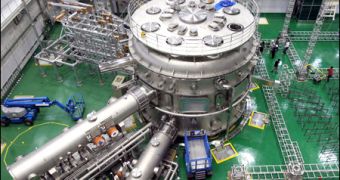An important step towards the creation of the first commercial nuclear fusion reactor has been taken last week as the South Korean authorities revealed that the KSTAR reactor, short for Korea Superconducting Tokamak Advanced Reactor, conducted its first experiment by producing a sustained field of super-hot plasma. The KSTAR reactor is part of a series of pilot devices expected to demonstrate that nuclear fusion reactions can be sustained efficiently on Earth, a process scheduled to end with the building of the International Thermonuclear Experiment Reactor in France by 2050.
Nuclear fusion is a physical process involving the fusion of two atomic nuclei into a single stable one, during which time a considerable amount of energy is produced. On the Sun, which fuses hydrogen and other heavy elements to produce energy, this process is relatively simple as the pressure and temperature conditions are met with relative ease. However, on Earth the temperature and pressure conditions will never see two atomic nuclei merge.
Therefore, nuclear fusion reactors must be built to create the proper conditions. As you might have realized in the last three decades or so, energy is becoming even more expensive as fossil fuels grow scarce. Now, that wouldn't be that big of a deal in the long run, but burning fossil fuels produces carbon dioxide and quite a lot of it too, thus impacting the atmosphere and triggering global warming, which is not that patient and is already showing some disastrous effects throughout the world.
Out of all the alternative fuel energy sources, nuclear fusion appears to have the greatest potential since it produces close to no waste and virtually unlimited amounts of energy whereas fuel (hydrogen) can be found abundantly all over the planet and in the universe (making more than 99 percent of all ordinary matter). The problem so far is that Tokamak reactors, the most promising of all types of nuclear fusion reactors, require an amount of energy (just to maintain the magnetic field keeping the plasma field confined, thus meeting the fusion conditions) greater than the one produced so far, thus they are inefficient for now.
The pilot devices preceding ITER have the purpose of demonstrating that nuclear fusion reactors can become efficient in the near future. "Today's demonstration was highly successful," said Kwon Eun-Hee, spokeswoman for the National Fusion Research Institute, the facility responsible for the operation of the KSTAR reactor.
The build of the device was finished last year in September and had a budget of 306 million dollars. In the following months, KSTAR is scheduled to conduct tests by creating a 20 second sustained plasma field, after which it will receive an upgrade that should make the reactor able to sustain plasma for up to 300 seconds.
South Korea is just one of the international partners in the ITER project and will contribute to the research with 5.1 billion dollars by 2015, a rather understandable reaction considering that Korea has close to no natural resources. A staggering 40 percent of the total energy output of the country is currently produced in nuclear fission reactors.

 14 DAY TRIAL //
14 DAY TRIAL //